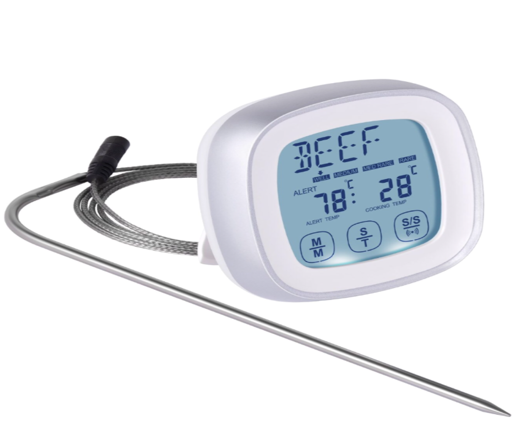How to Cook Your Meat and Fish to the Perfect Temperature

I think two of the most overlooked and underutilized pieces of kitchen equipment you can have in your cooking arsenal are a timer and a good probe thermometer.
These two inexpensive tools have saved my rear end more times than I can count, and I’m a professional chef with a pretty solid, innate sense for time and temperature.
For the average home cook, I’m going to stop short of calling them “essential,” but I will say this: once you start using them, you’ll wonder how you ever went without.
How to Choose a Kitchen Timer
A kitchen timer isn’t really something you need to go out and buy. A lot of stovetops have them built-in, as do microwaves and smartphones.
I use an iPhone app called Timer+ that allows me to set and label multiple timers at once – a fabulous resource for cooking big meals when you’re cooking several dishes at the same time.
The hardest part is getting into the habit of using timers since it always feels like a pain to set them, but that 10 seconds it takes to set a timer can save you hours of extra work trying to fix a dish that was overcooked, not to mention wasted food and money when you need to toss it.
Most cooks have a story about the day they learned the importance of the timer. For most, it revolves around something like a $300 hunk of prime rib that they turned into shoe leather.
For me, it was less dramatic. Mine was the day I burnt four batches of croutons.
Each time I told myself, “I won’t forget to check the croutons in 20 minutes,” but each time filling the kitchen with the smell of smoke.
After that, I never failed to set a timer for the croutons, and I never burned another batch.
But timers aren’t just useful for avoiding the catastrophic failure of charred food. They’re also great to have around when following a recipe because, quite frankly, most of us have no idea how long a minute is.
I know that sounds funny, but it’s true. We’re always in a hurry, always strapped for time to get the meal done, or just plain starving and anxious to eat.
The recipe says to sear the chicken breast five minutes per side, and there we are two minutes later, flipping that meat too early, only to find out when we cut into it that it’s still pink in the middle and we have to go back to the stove.
In this situation, a timer can be the ultimate impatience-buster.
Timers also make great teaching tools. Pop on a timer when you start sautéing your carrots and learn how long it takes for them to soften, or learn how many minutes your spaghetti had to boil to reach that perfect al dente texture.
Taking a moment to learn as you work will make you a better and more efficient cook in the future.
So, whether it’s your phone, your microwave, or one of those little wind-up eggs, find a timer that works for you, something easy to use and hard to lose.
Put it on the counter next to you when you begin to cook, and it’ll be ready to make your life a whole lot easier when you need it.
How to Choose a Food Thermometer
Now let’s talk about thermometers. A good probe thermometer is a worthwhile investment.
They’ll usually set you back anywhere from $15 to $30, but will give you years of use. Look for a model with a digital read-out, a probe that attaches to the read-out by means of a long wire, and an alarm that can be set to go off when it reaches a given temperature.
Here is a picture of what I mean:

This type of thermometer is great for when you’re roasting something in the oven, like a turkey or tenderloin.
You can pop the probe into the thickest part of the meat, set the alarm for your desired temperature, place the read-out on the counter next to the oven and forget the whole thing until the alarm goes off.
Then, presto, perfectly cooked meat every time.
When using this technique, just remember to bury the probe in the meat all the way up to where the probe bends. If too much of the probe is exposed to the hot oven, you’ll end up with a false reading.
Also, avoid hitting a bone with the tip of the probe, which would inhibit you from putting the probe all the way in, for the same reason.
You can also use this technique when baking loaves of bread in the oven.
These thermometers aren’t just good for checking temperatures in the oven, they can also be used when cooking on the grill or on your stovetop to quickly check the temp of steaks, chops, burgers, chicken breasts, or fish.
It takes the guesswork out of the process and gives you verifiably perfect results, every time.
How to Cook Chicken to Keep it Tender And Juicy
Common questions I get regarding meal prep is: “How do I cook my chicken breasts without drying them out?” “Is the oven OK?” “Should I use the broiler? Poach? Grill?”
The lengths to which people will go to avoid that dry, tough meat are really impressive.
Unfortunately, all of these options are usually pretty ineffective, which is why my answer is always the same: “It’s not so much how you cook it; the importance is to not overcook it.”
Chicken breast, when cooked to the right temperature is naturally tender and juicy, but it dries out very fast when overcooked, not only losing its juices but turning tough in the process.
The safe, internal temperature for chicken is 165 degrees F, but all meats continue to rise in temp even after they’re removed from the heat.
So, I always pull mine around 161 degrees F, and let it finish those last few degrees off the heat. It’s a technique you should use with all your meats.
Just remember, the thicker the meat, the more heat it will gain after taking it off the heat. That’s my secret to perfectly juicy and tender chicken, and it works no matter how you choose to cook it.
But the only way to know you’ve got it right is to use your trusty thermometer.
And one last thing: It’s a good idea to check the calibration of your thermometer once every few months.
You can do this by submerging the probe in a glass of ice water and stirring for 30 seconds or so. If your thermometer is accurate, it should read 32 degrees F (the temperature of ice).

